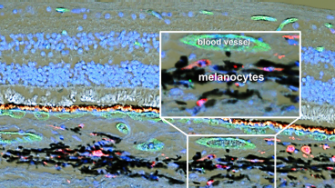
The choroid is a pigmented vascular layer found between the light sensitive retina and the outer tough scleral coat of the human eye, that provides nutrition and waste removal critical for maintaining normal outer retinal function. The choroid is a complex tissue of extracellular matrix, interwoven with blood vessels, nerve fibres and cells, including numerous pigment-containing cells (melanocytes) primarily recognised for absorbing light. Recent evidence shows that choroidal melanocytes may play other roles including absorbing free radicals and responding to inflammation.
How choroidal melanocytes respond to inflammation at a gene and protein level, including the signalling pathways and molecules involved, remains a key question for understanding their unique biology. We studied the biological responses of melanocytes stimulated with proinflammatory LPS (lipopolysaccharide) using transcriptome and gene pathway analyses, and other protein-based methods. The results confirmed not only a proinflammatory shift in biological processes and gene networks, but other novel gene and protein expression patterns related to mediating immune cell migration, cell-cell and cell-extracellular matrix adhesion, and angiogenesis. We also found robust gene and protein evidence for melanocyte expression of melanocortin receptor 1 (MC1R), a key regulator of pigmentation and inflammatory responses, in contrast to the equivocal findings reported to date. This included a first comparison of global gene expression patterns for human skin melanocytes (from Haltaufderhyde & Oancea, 2014) versus human choroid melanocytes (current study), starting with melanin-related genes including MC1R.
Our study sheds light on how choroidal melanocytes can play important roles in maintaining and regulating the complex choroidal microenvironment, normally, and in response to inflammation.
This collaborative study was led by Adrian Cioanca (UNSW BAdvSci (VisSci) (Hons), now PhD candidate, ANU), and involved researchers from Optometry and Vision Science UNSW, The University of Sydney, The Australian National University (ANU) and Leiden University Medical Center (LUMC, The Netherlands). Support from The Ophthalmic Research Institute of Australia, ARVO Foundation EyeFind Research Grant, Sydney Eye Hospital Foundation, and The National Health and Medical Research Council is gratefully acknowledged.
